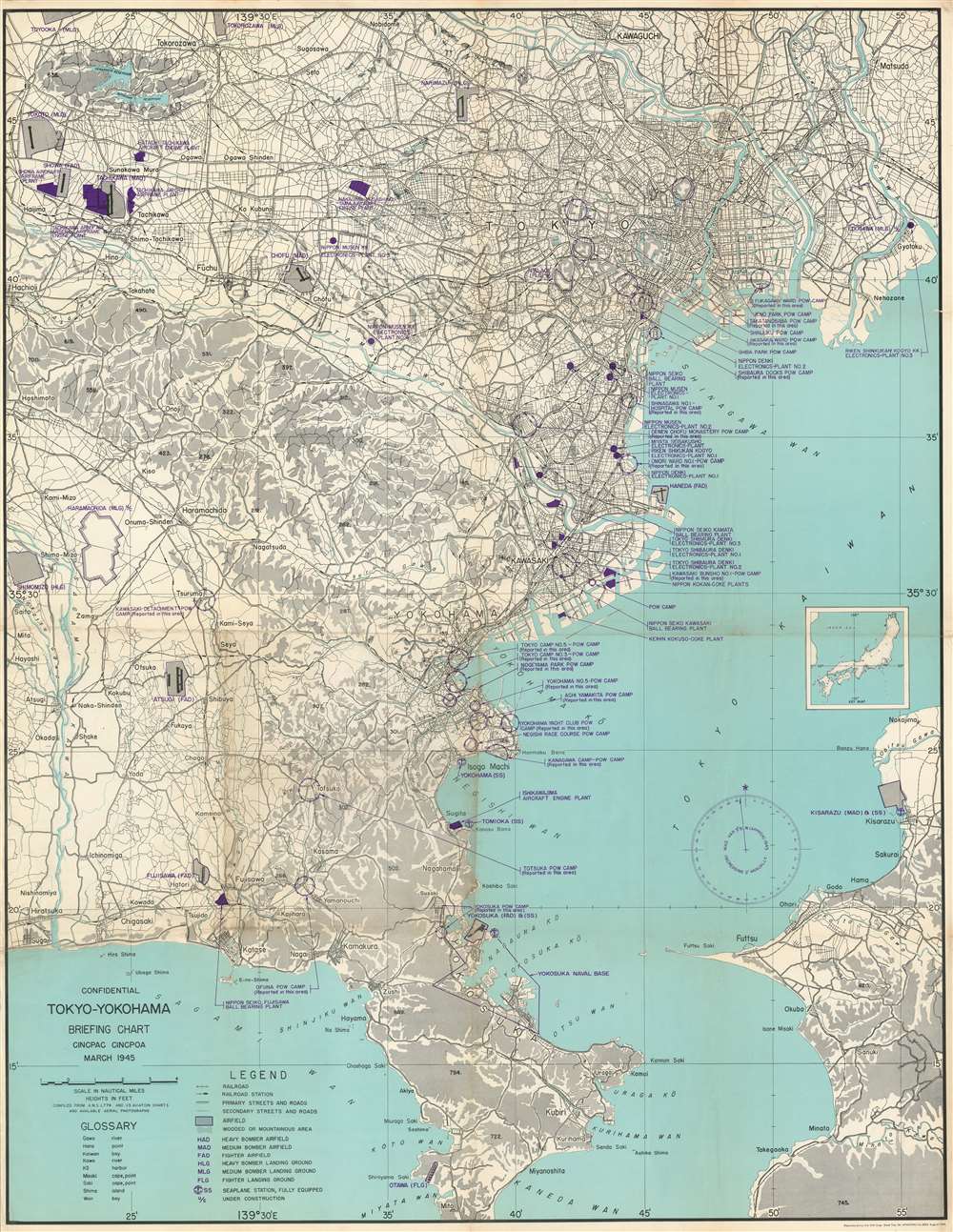This item has been sold, but you can get on the Waitlist to be notified if another example becomes available, or purchase a digital scan.
1945 CINCPAC Map of Japanese Prisoner of War Camps in Tokyo and Yokohama
TokyoYokohama-cincpac-1945$500.00

Title
Confidential Tokyo-Yokohama Briefing Chart CINCPAC CINCPOA March 1945.
1945 (dated) 45 x 35 in (114.3 x 88.9 cm) 1 : 61380
1945 (dated) 45 x 35 in (114.3 x 88.9 cm) 1 : 61380
Description
This is an August 1945 map of Tokyo and Yokohama prepared by the Headquarters of the Commander in Chief of the Pacific Fleet (CINCPAC) and the Headquarters of the Commander in Chief of the Pacific Operations Area (CINCPOA). One of the most intriguing American maps of the Tokyo / Yokohama area we have seen, factories producing critical war-related materials and Prisoner of War (POW) camps are highlighted by purple overprinting. As this map was 'reproduced by the 30th Engineer Base Topographical Battalion', there is a good chance that it was created in preparation for Operation DOWNFALL, the planned Allied invasion of the Home Islands of Japan. This invasion never took place because Imperial Japan surrendered to the United States after the atomic bombings of Hiroshima and Nagasaki in August 1945.
Japanese Prisoner of War Camps
Since the Allied forces were unable to know the precise location of the Japanese POW camps, each of the twenty-three different camps labeled here are marked by circles of barbed wire with the disclaimer that the POW camp was 'reported in this area'. It is difficult to identify exactly which POW camps are marked here, but it appears that one of the most infamous, the Omori POW Camp, is labeled here as 'Omori Ward No. 1 - POW Camp'. The Omori camp was located on a man-made island built to isolate POWs, particularly the Commanders of the USS Grenadier, the USS Houston, and the USS Tang. Louis Zamperini, the author of the bestselling book Unbroken was also housed there.Japanese Factories and War Production
Numerous different factories are highlighted here, generally with much more precision than the POW camps. Aircraft engine plants, ball bearing plants, and electronics plants are labeled. Ball bearings, which today feel insignificant today, but they were integral to war production. Ball bearings were vital components in aircraft, tanks, automobiles, guns, submarine engines, and more. These small manufactured products, and the machinery for producing them, were among the most sought-after resources of the war. Two ball bearing factories are highlighted here, but, unlike in many other cities during World War II, these factories were not explicitly targeted by a bombing raid. Tokyo had been mostly ignored by American bombers after the stunning April 18, 1942 Doolittle Raid, but the city suffered a devastating firebombing on the night of March 9-10, 1945, which destroyed sixteen square miles of central Tokyo, and is considered to be the most devastating aerial bombing raid in human history.Census and Publication History
This map was compiled by the Headquarters of CINCPAC and CINCPOA from aviation charts and aerial photographs. We have been unable to locate any other examples.Condition
Very good. Wear along original fold lines. Verso repairs to fold separations. Blank on verso.

